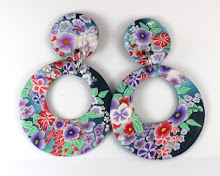I needed a quick and easy St. Patrick's Day project for tomorrow, so I compiled this four leaf clover box. Print it out and it's ready to color, cut and fold up into a envelope-box.
Wednesday, March 16, 2016
Monday, October 19, 2015
Polymer Clay Landscape Cane Tutorial
Step 1:
Start with the sunset color blend or any color you would like for the canyon walls.
Step 2:
Divide the blend into two parts.
This could also be done with blue to make sky instead of pure light. It can also look good to cover the cane in sheets of clay as a border.
Start with the sunset color blend or any color you would like for the canyon walls.
Step 2:
Divide the blend into two parts.
Step 3:
Stack the smaller part like this.
Step 4:
Mix a very, very light yellow. You may be able to use a tiny bit of the lightest part of your cane mixed with white. Flatten and stretch the light clay so thin that in begins to tear. Slice into the block and add little pieces of the light clay.
Step 5:
Keep going until you get close to the top. For the last three sections cut a little off the ends and re-attach it. Then slice another section a little higher from what is left and cut even more from the ends. Finally there will be a stair-step line for the water. Cover each layer with light clay. These are the sparkles of light on the water.
Step 6:
Now for the canyon walls! The idea is to show the layers of sandstone with slight variation within each layer. Cut the remaining blend into four parts and roll them into balls.
Step 7:
Roll the balls into logs and flatten them into fat ribbons. Slice up the ribbons and stack them into blocks.
Step 8:
Cut the darkest block into two pieces. These are the canyon walls in the foreground. The light in coming in from the background, so each part of the canyon gets lighter as you more into the canyon.
Step 9:
I chose to show only one wall with the light colored block. The very last of the light in the background is the rest of the light color that I used as sparkles on the water.
This could also be done with blue to make sky instead of pure light. It can also look good to cover the cane in sheets of clay as a border.
This cane was inspired by this painting lesson, but wow there are some gorgeous pictures of slot canyons online if you just do an image search. Now that you know how to make the variegated lines, imagine the beautiful variations!
Sunday, May 17, 2015
Steel Wool Light Painting Photography
Sometimes you have to take a break in the routine and create something completely different! What an amazing date. My boyfriend took me out last night to try some steel wool photography. Here is a youtube video about how it was done. There are moments in life so magical that later I wonder if it was only a dream.
Thursday, July 3, 2014
Polymer Clay Kawaii Animal Canes
Wow! Picture canes are hard! I tried this little fox and gave up on the rest. Still, just in case you might want to use these, here are some patterns for cute little animal canes. Good luck!
Kawaii monkey, elephant, fox, owl, panda, bunny, kitten, koala and penguin!
Thursday, May 1, 2014
Polymer Clay Fish Sculpture Tutorial
Step 1:
Make Skinner blend sheets at the thickest setting on your pasta machine or cut slices from skinner blend blocks. These are small sheets. Just 1.5" X 1.5". You will need two sheets of each color. This you tube video shows how to make these block blends https://www.youtube.com/watch?v=UtxXtbd2vaw
Step 2:
Layer the sheets so that the dark and light ends are together.
Step 3:
Make two jelly roll canes. One cane will start rolling with the solid colors. The other cane will start the roll along the blends.
Step 4:
Form a fish body. For this one I used a ball of clay 1.6" in diameter.
Step 5:
Use the jelly roll with the color gradient to layer slices on the body like scales. Start at the tail and work towards the head.
Step 6:
Flatten the other jelly roll cane. Slice it in half. Sack the layers and repeat until you have a very short block cane with as many layers as you want.
Step 7:
Cut slices from the layered cane. Gather and squish one end of each slice to make the fins and tail.
Step 8:
Cut slits into the body of the fish to insert the fins. I learned this trick from a fellow member of the Tucson Polymer Clay Guild. If there is someone else I need to cite please let me know!
Step 9:
Add eyes and a mouth.
Here are some variations.
Subscribe to:
Posts (Atom)



















































